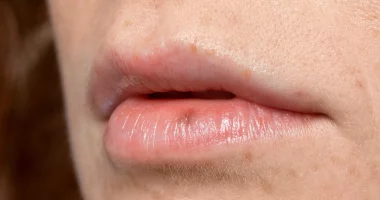Cellulitis is an infection caused by bacteria that affects the deeper skin layers, including the soft and fat tissues below. People with cellulitis often experience symptoms like skin swelling, redness, and sensitivity in the affected area. The condition usually needs treatment with antibiotics to help clear the infection.
In the U.S., there are about 14.5 million episodes of cellulitis reported each year. Normally, particularly bacteria live harmlessly on the skin’s surface. However, if these bacteria enter the epidermis through a cut, graze, or insect bite, they can cause an infection like cellulitis.
It’s important to note that cellulitis is different from cellulite, which is a harmless condition where the skin on the thighs and upper arms may have a dimpled or “orange peel” appearance.
Symptoms
Cellulitis typically starts as a pink, swollen, or red area of skin that can grow in size and intensity as the infection progresses. In the affected area, individuals may notice swelling and discoloration, along with warmth, pain, and sensitivity. Some individuals might also experience the development of skin dimpling, blisters, or spots.
Besides these localized symptoms, an individual with cellulitis might also show signs of a more general infection. These can include feelings of extreme tiredness, chills, cold sweats, fever, shivering, and nausea. Additionally, the infection can cause lymph glands to swell and get sensitive. For instance, the leg might lead to swollen glands in the area of the groin.
Treatment
Early intervention of cellulitis with antibiotics is typically effective. Most individuals can be treated at home, however in some cases, hospital treatment may be necessary.
Medication
For mild episodes of cellulitis, oral antibiotics are usually suggested for 1 to 2 weeks. Although symptoms might primarily worsen, they generally begin to improve within two days. There are various kinds of antibiotics available to treat cellulitis, and the healthcare provider will select the most appropriate one based on the particular kind of bacteria causing the infection and individual patient factors.
Most individuals recover from cellulitis in two weeks, although recovery might take longer if the signs are serious. In some cases, a healthcare provider may suggest a low-dose antibiotic for long-term use to assist stop the infection from recurring.
Hospital Treatment
In more severe cases of cellulitis, hospital intervention may be required. This is especially true if the person has a high temperature, is experiencing vomiting, has recurrent cellulitis, or if the current intervention is not effective and symptoms are worsening. In the hospital, patients typically receive antibiotics through an intravenous drip, which gives the medicine directly into an arm vein for faster and more effective treatment.
Causes
Cellulitis is typically caused by bacteria, most commonly from the Staphylococcus groups. These microorganisms normally live on the skin’s surface without causing any problems. But, if they begin the skin through a break, like a scratch or cut, they can lead to an infection, resulting in cellulitis.
While cellulitis itself is not typically contagious, it can potentially be transmitted if an infected individual with a wound comes into contact with another person’s broken skin. This is why it’s important to take care of any wounds and practice good hygiene to prevent the spread of bacteria.
Diagnosis
To diagnose cellulitis, a healthcare provider will examine the patient and evaluate their signs. They might ask about any medicines the patient is taking, as well as their signs and person’s medical issues. This helps the healthcare provider understand the context and possible causes of the infection.
In some cases, the healthcare provider may take a swab sample from the infected area or perform a biopsy to identify the specific kind of bacteria causing the infection. Lab tests can also assist in eliminating other conditions that may present similar symptoms.
Finding the exact cause and kind of bacteria is crucial for prescribing the most appropriate intervention. However, this process might be challenging, as the skin often hosts different kinds of bacteria, which can sometimes lead to inexact test results. Despite these challenges, accurate diagnosis is key to ensuring effective treatment and recovery.
Complications
In rare cases, cellulitis can lead to severe complications. One potential complication is permanent inflaming in the impacted area if the infection is not properly treated. This condition, known as lymphedema, can cause persistent swelling and discomfort.
Another severe complication is a blood infection, known as sepsis. Sepsis occurs when bacteria from the cellulitis enter the blood flow, leading to a dangerous condition. Symptoms of sepsis include fever, quick heartbeat, fast breathing, hypotension, dizziness, decreased urine, and skin that appears pale, sweaty, and cold. Sepsis requires immediate medical attention.
In very rare instances, the bacteria responsible for cellulitis can transmit to other areas of the body, like the bones, muscles, or heart valves. This spread can lead to infections in these areas, necessitating urgent treatment to prevent further health complications.
Most of these complications can be prevented with prompt and effective treatment of cellulitis. Recognizing symptoms early and seeking medical care can help ensure a swift recovery and reduce the risk of these serious outcomes.
Summary
Cellulitis is an infection of the deeper skin layers, often caused by Staphylococcus bacteria. It presents with symptoms like swelling, redness, and tenderness, and can lead to severe complications like sepsis and permanent inflammation if untreated. Risk factors include age, obesity, skin conditions, and a weakened immune system. Diagnosis involves a medical examination and sometimes lab tests to identify the bacteria. Treatment typically involves antibiotics, with severe cases requiring hospitalization. Preventative measures include proper wound care, good hygiene, and managing underlying health conditions.









